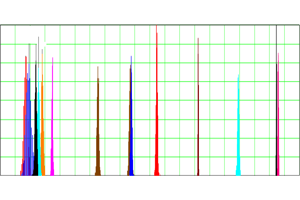Application of predictability index for process classification in information and communication systems
DOI:
https://doi.org/10.3103/S0735272724060013Keywords:
information and communication systems, predictability index, identification scale, process classification, radioelectronic intelligenceAbstract
The modern development of information and communication systems (ICS) in the context of the widespread use of radio signals with statistical and dynamic characteristics close to those of white noise requires new approaches to the correct decision-making on the natural or artificial character of the process observed during the electronic intelligence.
In this paper, we propose to use the SG (Savit and Green) predictability index to classify the processes used in ICS. With the help of the proposed identification scale, which uses SG index as a parameter, the processes are analyzed and conventionally divided into three classes: IID-processes, chaotic processes with a destructured image in pseudo-phase space (IPPS), chaotic processes with a structured IPPS, and periodic processes. For each process, a histogram of the distribution of SG values on the identification scale is plotted.
Based on the conducted analysis, it was established that the identification scale based on the SG value effectively distinguishes not only classes of processes (for example, random, chaotic, and deterministic), but also processes within individual classes, for example, it distinguishes chaotic processes with destructured and structured IPPS. The results demonstrate statistical significance and reliability of the new classification method, making it promising for use in real ICS.
References
- P. Y. Kostenko, S. Y. Falkovich, Foundations of Statistical Theory of Information-Measuring Radio-Engineering Systems. Kharkiv: KhNUPS, 2021.
- D. Shamanov, A. Sorokin, “Analysis of modern methods of electronic warfare,” Control. Navig. Commun. Syst., vol. 1, no. 75, pp. 211–214, 2024, doi: https://doi.org/10.26906/SUNZ.2024.1.211.
- K. T. Koshekov et al., “Modernization of vibration analyzers based on identification measurements,” Russ. J. Nondestruct. Test., vol. 54, no. 5, pp. 328–334, 2018, doi: https://doi.org/10.1134/S106183091805008X.
- Y. N. Klikushin, V. Y. Kobenko, “Identification method of signal classification,” Omsk Sci. Bull., no. 2, pp. 267–272, 2013.
- Y. N. Klikushin, V. Y. Kobenko, P. P. Stepanov, “Basics of identification measurement technology,” J. Phys. Conf. Ser., vol. 94412050, 2018, doi: https://doi.org/10.1088/1742-6596/944/1/012050.
- C. Vasyuta, “Classification of process in infocomunication radiotehnic systems using BDS-statistics,” Probl. Telecommun., no. 4, pp. 63–71, 2012, uri: https://pt.nure.ua/articles/klassifikaciya-processov-v-infokommunikacionnyh-i-radiotehnicheskih-sistemah-s-primeneniem-bds-statistiki/.
- W. A. Broock, J. A. Scheinkman, W. D. Dechert, B. LeBaron, “A test for independence based on the correlation dimension,” Econom. Rev., vol. 15, no. 3, pp. 197–235, 1996, doi: https://doi.org/10.1080/07474939608800353.
- R. Savit, M. Green, “Time series and dependent variables,” Phys. D Nonlinear Phenom., vol. 50, no. 1, pp. 95–116, 1991, doi: https://doi.org/10.1016/0167-2789(91)90083-L.
- P. Y. Kostenko, V. V. Slobodyanuk, A. N. Barsukov, “Stealthiness of analytical chaotic signals,” Radioelectron. Commun. Syst., vol. 60, no. 3, pp. 132–140, 2017, doi: https://doi.org/10.3103/S0735272717030050.
- Z. Xu, X. Wang, Y. Wang, “Nonlinear frequency-modulated waveforms modeling and optimization for radar applications,” Mathematics, vol. 10, no. 21, p. 3939, 2022, doi: https://doi.org/10.3390/math10213939.
- G. Guven, “Testing equality of means in one-way ANOVA using three and four moment approximations,” Commun. Fac. Sci. Univ. Ankara Ser. A1Mathematics Stat., vol. 72, no. 3, pp. 587–605, 2023, doi: https://doi.org/10.31801/cfsuasmas.1252070.
- S. Wang, C. Wang, C. Xu, “An image encryption algorithm based on a hidden attractor chaos system and the Knuth–Durstenfeld algorithm,” Opt. Lasers Eng., vol. 128, p. 105995, 2020, doi: https://doi.org/10.1016/j.optlaseng.2019.105995.


